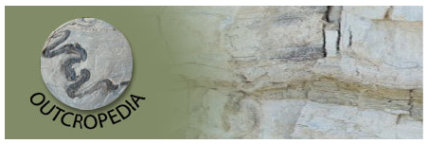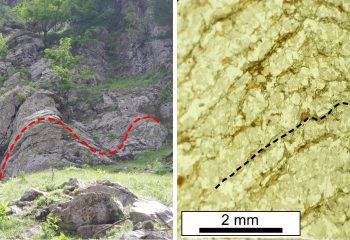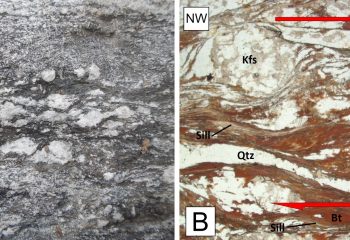Variscan transpressional deformation in the Argentera Massif (Italy) by Matteo Simonetti, University of Torino, Italy The Argentera Massif is located at the boundary between Italy and France and is the southernmost of the Alpine External Crystalline Massifs. The basement of the Argentera Massif shows elegant folded and sheared Variscan migmatites only locally affected by Alpine…
Variscan transpressional deformation in the Argentera Massif (Italy)
by Matteo Simonetti, University of Torino, Italy
The Argentera Massif is located at the boundary between Italy and France and is the southernmost of the Alpine External Crystalline Massifs. The basement of the Argentera Massif shows elegant folded and sheared Variscan migmatites only locally affected by Alpine tectonics. This Massif is divided in two metamorphic complexes made by high-grade migmatitic gneisses: the southwestern Tinèe Complex (TC) and the northeastern Gesso-Stura-Vesubiè Complex (GSV). They are separated by a NW–SE oriented 25 km long shear zone known as the Ferriere-Mollière shear zone (FMSZ). In the northern sector the FMSZ reach its maximum thickness of nearly 2 km.
The FMSZ is a transpressive ductile shear zone showing a dextral movement. Its activity is linked to the late-Carboniferous transpressional event that characterize many Variscan fragments in the Mediterranean area such as the Corsica-Sardinia Block and the Maures Massif. Mylonites of the FMSZ result from the shearing of the migmatites belonging to both the GSV and the TC. Different types of mylonites were recently distinguished and mapped by Carosi et al. (2016) taking into account the percentage of matrix and porphyroclasts both at the meso- and at the microscopic-scale. A deformation gradient marked by a transition from protomylonite, mylonite and ultramylonite has been detected.
The main lithotypes in the shear zone are medium grained dark-green mylonitic schists and biotite and white mica bearing mylonitic gneisses. Embedded within the mylonitic schists amphibole-bearing gneiss, showing variable amounts of deformation, are present.
Simonetti et al. (2018) recognized that deformation within the FMSZ progressively concentrate in the core of the shear zone. This leaves the margins inactive and the active part gets progressively thinner, in agreement with a type II evolution. They also dated the initiation of the between 340 Ma and 330 Ma.
Detailed investigation of the main mineral recrystallization mechanisms and of the syn-kinematic mineral associations along the deformation gradient, revealed that the activity of the shear zone happened under decreasing temperature conditions (from high-temperature amphibolite-facies to greenschist-facies). High-temperature paragenesis are preserved in the margin of the shear zone while lower temperature assemblages are recognizable in the core of the structure.
The aim of the guide is to show some key outcrops that allow to recognize the increasing deformation gradient toward the core of the FMSZ. The outcrops are located in the Valle Stura di Demonte (CN, Italy) in the Pontebernardo valley.
References
Carosi R., D’addario E., Mammoliti E., Montomoli C., Simonetti M., 2016, Geological map of the northwestern portion of the Ferriere-Mollieres shear zone, Argentera Massif, Italy. Journal of Maps, 12, 466-475.
Simonetti M., Carosi R., Montomoli C., 2017, Variscan shear deformation in the Argentera Massif: a field guide to the excursion in the Pontebernardo Valley (CN, Italy). Atti della Società Toscana di Scienze Naturali Memorie, Serie A, 124, doi: 10.2424/ASTSN.M.2017.02.
Simonetti M., Carosi R., Montomoli C., Langone A., D’Addario E., Mammoliti E., 2018, kinematic and geochronological constraints on shear deformation in the Ferriere-Mollières shear zone (Argentera-Mercantour Massif, Western Alps): implications for the evolution of the Southern European Variscan Belt. Int J Earth Sci, 107, 6, 2163-2189. doi: 10.1007/s00531-018-1593-y
-
1
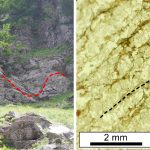
Migmatites of the Gesso-Stura-Vesubie Compelx
In the first outcrop (fig. 1a) migmatites of the GSV, formed at the expense of metasedimentary rocks, can be observed. These rocks, located outside the FMSZ, are medium-grained migmatitic gneiss with a quartz-plagioclase-biotite-fibrolitic sillimanite-cordierite assemblage with few K-feldspar and muscovite. Relict kyanite and garnet rarely included in plagioclase suggest that these rocks reached P-T conditions…
-
2
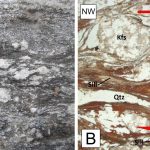
Protomylonites of the Ferriere-Mollières shear zone
Coarse grained protomylonitic gneiss (fig. 2a) with deformed leucosomes of K-feldspar, plagioclase and quartz in a medium grained biotite and sillimanite matrix with sometimes white mica. The amount of matrix is variable from a maximum of nearly 50% to a minimum of 30% – 40%. S-C fabric and asimmetric and stretched leucosomes are recognizable (fig….
-
3
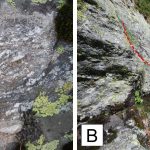
Mylonitic gneiss of the Ferriere-Mollières shear zone
Mylonitic migmatitic gneiss of the FMSZ (fig. 3a). These rocks present sheared leucosomes and K-feldspar, plagioclase and quartz porphyloclasts in a fine grained biotite and white mica matrix. The amount of matrix in this lithotype is about 50 – 60%. Asymmetric and stretched leucosomes are recognizable and points to a dextral top-to-the SW sense of…
-
4
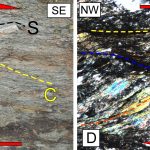
Ultramylonites of the Ferriere-Mollières shear zone
The most sheared rocks of the FMSZ crops out in the core of the shear zone, the outcrop showed here is located along the crest of the Costabella del Piz. They are ultramylonites (fig. 5a) with an amount of matrix over 90%. Foliation is marked by white mica and chlorite. This mineral assemblage is indicative…
